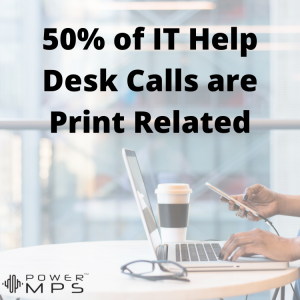Why IT Should Love Managed Print Services
The IT department seems to have a reputation for being curt, frustrated, and cranky. But that attitude is hardly surprising when you consider the majority of their interactions with other departments revolve around fixing complex technology-based problems. And if it isn’t a tech issue, it’s attempting to arrange times to install drivers or software to help keep the company’s network and information secure. Business printing is just one more of the many tasks IT oversees that can cause additional headaches.
Printers Eat Time
While most offices need printers, these machines are often set and forgotten until there is a problem. That’s when the help desk calls start rolling in. Ink and toner replacement, paper jams, and network communication issues are just a few of the wide range of everyday reasons employees call IT or submit help desk tickets. Around half (50%) of help desk calls are printer-related, accordin to a Gartner study.

Some of these problems are quickly resolved. But it is not only simple issues that generate printer-related calls to IT. For example, regular driver and security updates can block computers from sending documents or even recognizing available office printers when out of date. In addition, tracking when driver updates occur and arranging installation around regular work hours means additional planning and IT hours.
The same can be said of spooler crashes or other problems that require added maintenance. There is often a significant amount of time spent determining the magnitude of the malfunction before a printer technician can be called. Then there is the time and effort needed to manage visiting techs and ensure machines are back in working order before they leave.
All of these calls, tickets, and maintenance evaluations add up. Think about it. If there are one hundred help desk calls or tickets created in a day, an average of fifty would be printer-related. Assuming those printer issues each takes ten minutes to resolve, that is just over eight hours. That’s one employee’s entire day dedicated to dealing with the printer.
Printer Security
That set it and forget it attitude has another problem that plagues the IT department – security. Printing devices, whether network or local, have several general vulnerabilities. Even consumer-level printers have built-in hard drives which temporarily store the previously printed and queued documents. Should the printer be hacked, any confidential or proprietary information previously printed could be accessed.
But retrieving printed documents is only one potential problem should a machine be hacked. There is a risk of compromised devices providing backdoor access to any connected computers and, consequently, into the company’s computer network. Printer breaches account for eleven percent of all security incidents.
To reduce this risk, network printers should run on a secure VPN. IT must also work to ensure both printers are locked down, security is up to date across all machines, and IPP ports are closed. Adding additional document encryption and password protection levels is also recommended to reduce internal and external accessibility of past and future document printing.
Remote Work Accelerates Problems
Recent studies of post-pandemic business decisions show (83%) of global businesses intend to have over one quarter of their employees working remotely. US businesses, recognizing some of the difficulties at-home and hybrid workers faced during the pandemic, are also far more likely to provide printers for their remote employees. As of July 2020, forty-eight percent of US businesses had already provided dedicated printers to individual employees, and thirty-four percent had plans to do so.
IT has managed to adjust to the additional time and security measures required to maintain an onslaught of new office spaces. However, throwing more print devices on top of that already large workload is daunting for the department. More printers mean more potential maintenance issues, more helpdesk tickets, and practically doubling the work required to regularly update and monitor network-connected technology for security updates and attacks.
MPS Can Help
Rather than overload IT with new layers of work, organizations that acknowledge the importance of print within their business are regularly turning to Managed Print Services (MPS). In this changing landscape, MPS are working with their business partners to provide standard in-office solutions and A3 and A4 network printers for the growing remote workspace.
In addition to providing secure network print equipment, these companies also offer comprehensive service, monitoring, and security. They absorb print-related help desk questions, driver updates, ink, toner, paper supplies provision, and printer maintenance across their partners’ entire print fleet. This dedication to security, monitoring, and service is why over three-quarters (76%) of global organizations considered print security leaders partner with an MPS provider.
So, a larger print landscape could easily lead to additional headaches for IT. But there is a way to avoid the excessive help desk calls, maintenance headaches, and security worries surrounding the print environment – thanks to the availability of reliable MPS.
If you’re not convinced yet that businesses need MPS, CLICK HERE to learn 6 reasons why Your Business Needs Managed Print Services.
Learn more about Power MPS here


Comments (0)